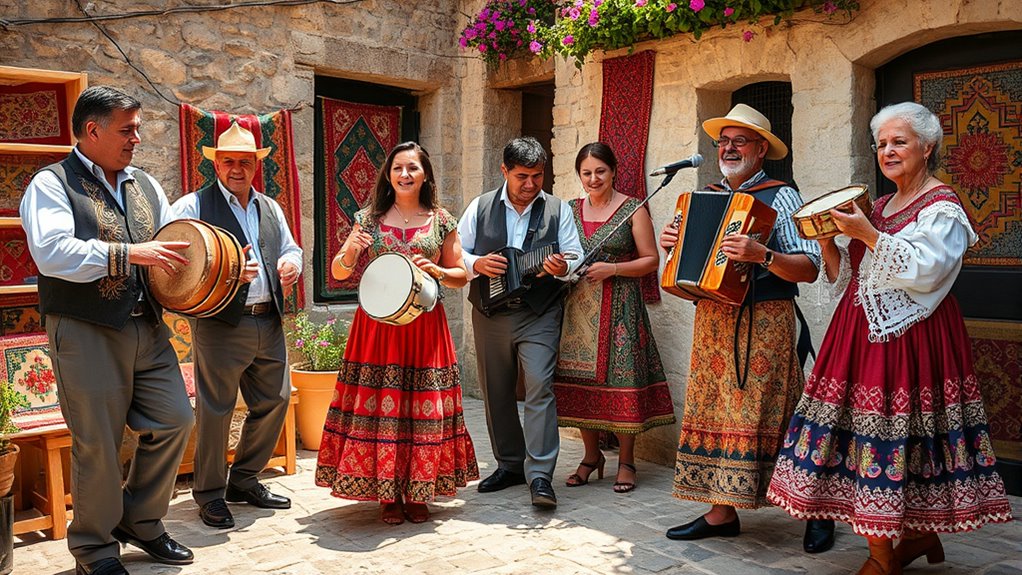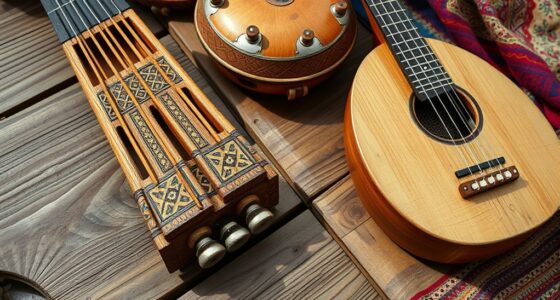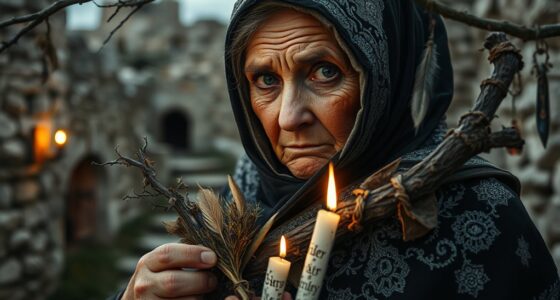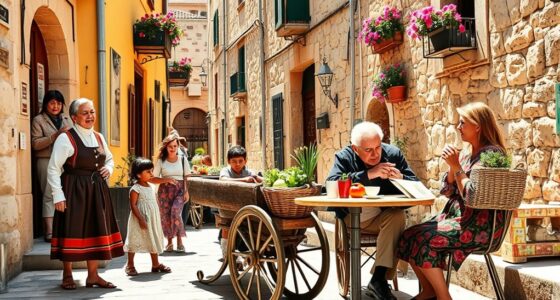Traditional Sardinian music and dance reflect the island’s rich cultural history, dating back over 3,000 years. You’ll encounter powerful vocal styles like *canto a tenore*, unique instruments such as launeddas, and lively, community-focused dances like *ballu tundu*. These traditions preserve local identity, connect communities, and celebrate seasonal rituals. To explore how these ancient sounds and movements continue to thrive today, keep discovering the stories and practices behind Sardinian heritage.
Key Takeaways
- Sardinian music dates back over 3,000 years, with unique vocal styles like *cantu a tenore* and polyphonic singing reflecting regional identity.
- The *cantu a tenore* involves four male voices—bassu, contra, boche, and mesu boche—performed in close circles without instruments.
- Traditional instruments such as launeddas, cane flutes, and Sardinian guitar create distinctive soundscapes supporting folk music.
- Regional dances like *ballu tundu* are circular, ritualistic, and symbolize community unity through rhythmic movement.
- Music and dance in Sardinia reinforce cultural pride, community bonds, and the preservation of ancient traditions amidst modern influences.
Origins and Historical Roots of Sardinian Music
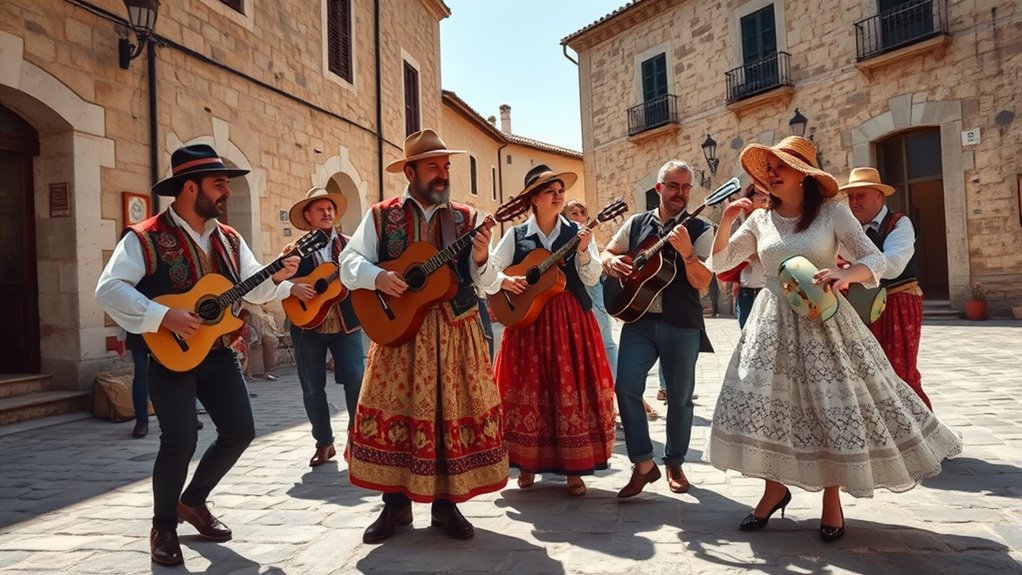
The origins of Sardinian music stretch back around 3,000 years, rooted in the island’s ancient pastoral communities. Archaeological findings, like a bronze statuette of a singing man, suggest early vocal traditions. The polyphonic style known as *tenores* may trace back to Nuragic civilization, linking it to Sardinia’s prehistoric past. However, Sardinia’s history of domination by Phoenicians, Carthaginians, Romans, and Arabs complicates precise dating. Ethnomusicologists estimate that structured polyphony, such as *canto ad accordo* or *falsobordone*, emerged around the 15th century, though oral traditions likely predate this. The island’s rugged landscape and isolated communities helped preserve these musical forms, fostering a unique cultural identity that endured despite external influences. Studies of ancient artifacts and inscriptions support the idea that these vocal traditions have very ancient roots, further emphasizing their deep historical significance. Additionally, geographic isolation played a critical role in maintaining the distinctiveness of Sardinian music through centuries.
Vocal Traditions: The Art of Polyphony and Cantu a Tenore
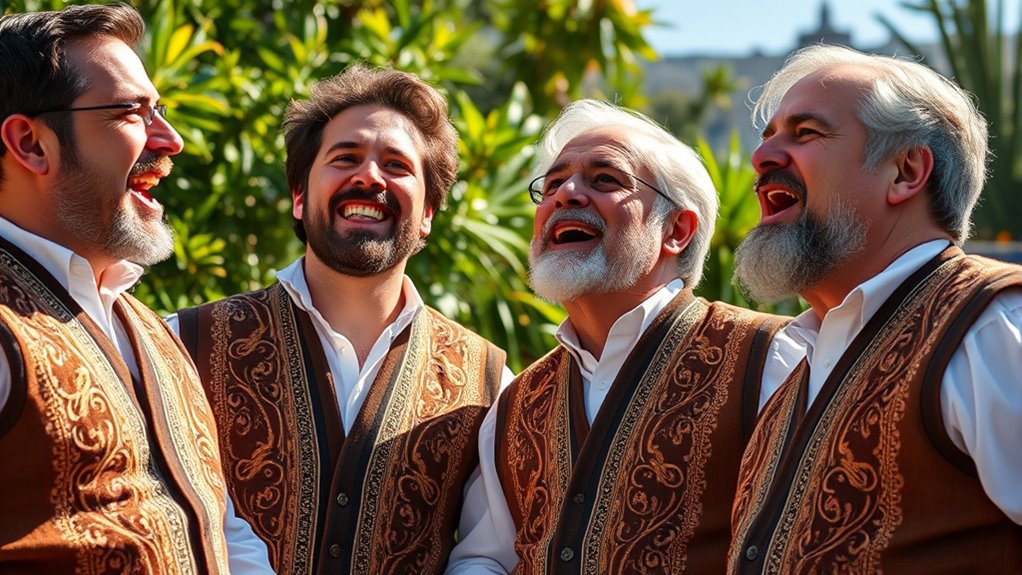
Vocal traditions in Sardinia showcase a remarkable form of polyphony known as *cantu a tenore*, which involves four distinct male voices working together to create a powerful, harmonious sound. You’ll hear deep, guttural tones from the bassu and contra, while the boche sings the main melody or poetry. The mesu boche harmonizes between them, all performed standing in a close circle. This style produces a rich overtone singing unique to Sardinia’s Barbagia region. The table below highlights the vocal roles:
| Role | Function |
|---|---|
| Bassu | Deep, guttural base tone |
| Contra | Guttural support, second-lowest |
| Boche | Soloist, delivers main melody or poetry |
| Mesu boche | Harmonizes, “half voice” between boche and lower voices |
Additionally, this singing style is often performed during traditional festivals, reinforcing community bonds and cultural identity.
Instruments That Define Sardinian Soundscapes
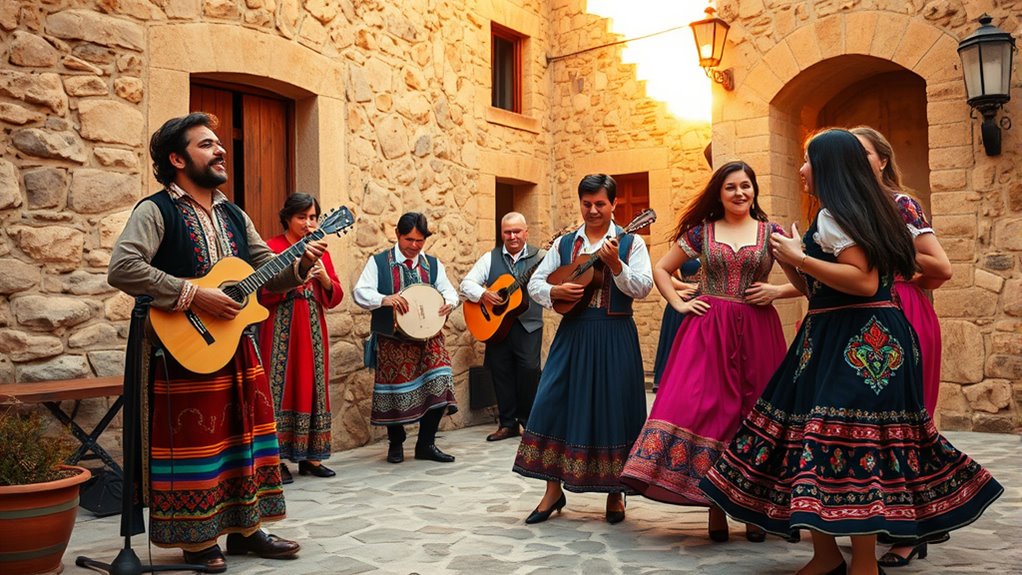
You can’t explore Sardinian music without highlighting the launeddas, a centuries-old wind instrument that defines the region’s sound. Alongside it, other traditional instruments like cane flutes and the scacciapensieri enrich the musical landscape. Together, these tools create the distinctive, vibrant soundscapes that characterize Sardinian folk music. The unique sound of these instruments is also shaped by the traditional playing techniques, which have been passed down through generations.
Launeddas: Ancient Wind Instrument
Launeddas stand out as one of Sardinia’s most iconic instruments, shaping the island’s unique soundscape through centuries of continuous tradition. Originating over 3,000 years ago during the Nuragic civilization, they’re depicted in 10th-century BC bronze statuettes and referenced in 13th-century documents. This triple-pipe wind instrument features a drone and two melody pipes, crafted from local cane and bound with wax. You play them using circular breathing, sustaining continuous sound and intricate melodies reminiscent of modal traditions like Maqam or Raga. Launeddas are deeply embedded in Sardinian culture, used in sacred and secular events, and symbolize the island’s musical identity. Their legacy continues today through skilled performers, maintaining a living link to Sardinia’s ancient sound heritage. Their enduring popularity highlights how these traditional instruments have maintained relevance across centuries.
Traditional Folk Instruments
Sardinian music is defined not only by the launeddas but also by a rich array of folk instruments that create the island’s distinctive soundscape. Wind instruments like benas, sulitus, pipiolos, organittu, and scacciapensieri add melodic and rhythmic layers. Percussion instruments such as tumbarinos, carnival drums, triangles, and repurposed molds drive dance rhythms. String instruments like the Sardinian guitar, often ornately decorated, provide melodic and harmonic support, especially in Cantu a Chiterra singing. Instruments linked to festivities include pipaiolu, triangulu, and tumbarino, essential during Carnival. Craftsmanship involves natural materials like goat skins, bamboo, and cane, reflecting resourcefulness and tradition. Additionally, the cultural significance of these instruments highlights their role in community celebrations and rituals.
Dance and Rituals: Celebrating Cultural Heritage
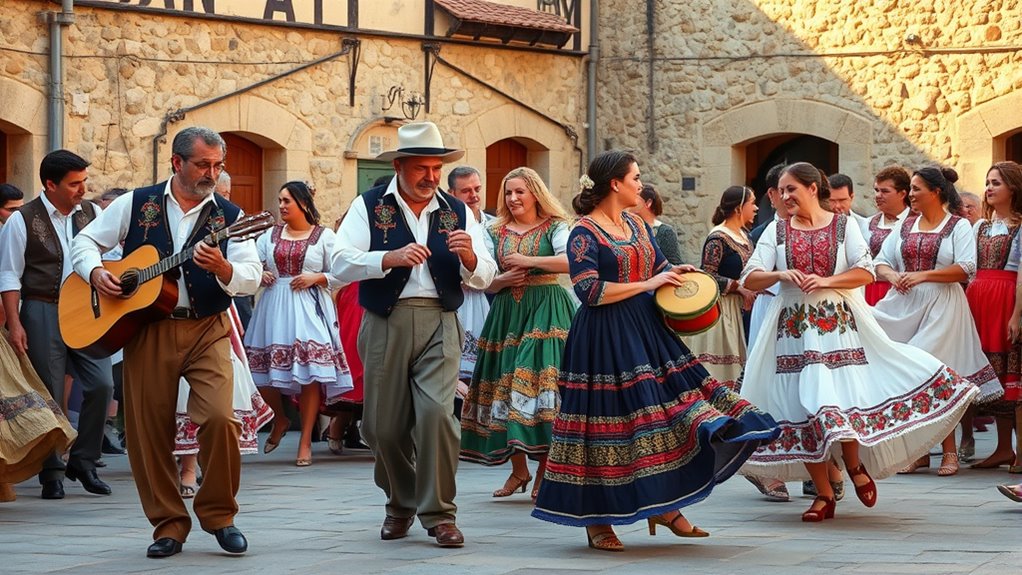
Dance and rituals in Sardinian culture serve as powerful expressions of historical identity, linking communities through shared traditions that date back thousands of years. You’ll notice each town has its own costumes and dance variations, like *ballu tundu* and *sa danza*, differing in rhythm and steps. The *ballu tundu*, performed in a circle, symbolizes unity, with dancers holding hands around a central musician, emphasizing the close bond between music and dance. Movements feature rhythmic “jolts” mainly from the lower body, believed to purify and protect. These circular dances have roots in ancient magic-rituals, reflecting deep cultural rites and communal participation. Such dance rituals celebrate seasonal changes and agricultural cycles, maintaining a crucial connection to Sardinia’s ancestral customs and community cohesion. Additionally, these dances often incorporate traditional instruments that have been used for generations, preserving the cultural heritage through music and dance.
The Cultural Significance of Traditional Music and Dance

Traditional music and dance serve as essential expressions of community identity in Sardinia, helping people connect to their shared history and cultural roots. When you participate in folk events, you strengthen social bonds and reinforce cultural pride, especially during festivals like the Cavalcata Sarda. These traditions embody collective memory, reflecting values and histories passed down through generations. Instruments like the launeddas and singing styles such as canto a tenore are not just musical forms—they’re symbols of resilience and continuity. Music and dance also play crucial roles in ceremonies, linking the spiritual and the communal, from religious processions to life-cycle rituals. Engaging with these traditions fosters a sense of belonging and cultural preservation, ensuring their relevance in contemporary society. By engaging with these traditions, you help preserve Sardinia’s unique cultural landscape amidst modern influences, ensuring its enduring significance for future generations. Traditional dances like Ballu tundu, Passu Torrau, and Dillu are often performed during community gatherings, further emphasizing their role in fostering social cohesion.
Musical Style and Characteristics of Sardinian Folk Music
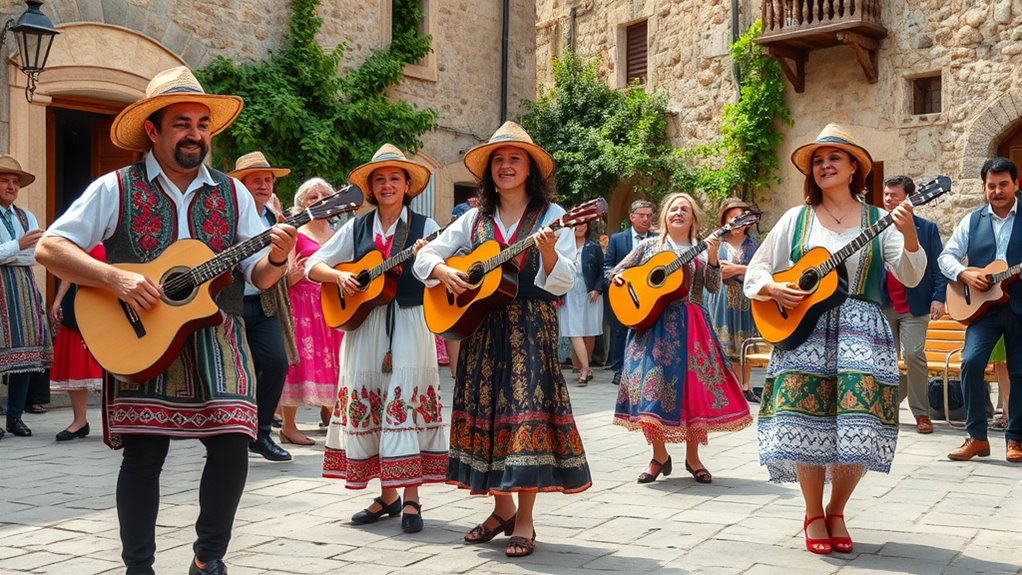
You can recognize Sardinian folk music by its distinctive polyphonic singing, where multiple voices harmonize to create a rich, layered sound. The style, like *cantu a tenòre*, features unique vocal techniques, including overtone singing that sets it apart from other polyphonic traditions. Regional variations add diversity, with styles such as *taja* in Gallura and *concordu* in Logudoro, all sung exclusively in Sardinian to preserve cultural identity. Performances are mostly a cappella, emphasizing vocal harmony and depth. The vocal roles are clearly defined, with deep bassu and contra voices forming the foundation, while *mesu boche* adds suspended harmonies. Singers often stand in a close circle, delivering emotionally expressive performances rooted in tradition and community. polyphonic singing is a key characteristic that highlights the complex vocal interplay unique to Sardinian music.
Frequently Asked Questions
How Has Sardinian Music Evolved in Modern Times?
You see how Sardinian music has evolved by blending traditional styles like canto a tenore with modern influences. Younger performers now incorporate instruments like slide guitar and address contemporary issues in their lyrics. They also use Sardinian language in pop, rock, and rap, reflecting social changes. While efforts to preserve the heritage continue, global recognition and innovation help keep Sardinian music essential and relevant today.
Are There Specific Festivals Dedicated to Sardinian Musical Traditions?
They say “music is the soul of a community,” and Sardinian festivals prove it. You’ll find dedicated celebrations like Sant’Efisio, which showcases traditional costumes, folk music, and dances rooted in centuries-old customs. Events such as Citrus Festival and Isole che Parlano blend old and new sounds, attracting crowds. These festivals keep Sardinian musical heritage alive, weaving community spirit and cultural pride into vibrant, unforgettable experiences for everyone involved.
What Role Do Women Play in Sardinian Singing and Dance?
You see that women historically played a essential role in Sardinian singing and dance, especially in polyphonic groups and community celebrations. While men dominate styles like cuncordu and cantu a tenore today, women continue to participate in dances like the ballu tundu, symbolizing community and fertility. Their presence in dance circles preserves cultural values, fosters social bonds, and maintains important traditions, even as musical roles evolve over time.
How Are Young People Engaging With Traditional Sardinian Music Today?
Imagine yourself stepping into a vibrant world where tradition meets today—young people actively embrace Sardinian music through immersive workshops, blending old melodies with new electronic sounds. You attend festivals, perform in public, and connect with peers worldwide via digital platforms. This dynamic engagement keeps Sardinian culture alive, like a flame passed from generation to generation, ensuring these treasured traditions continue to inspire and evolve with your creative spirit.
Are There Contemporary Artists Blending Sardinian Traditions With Modern Genres?
You’ll find that many contemporary artists are blending Sardinian traditions with modern genres. Iosonouncane, for example, mixes Sardinian cultural elements with current music styles, while BLUEM combines electronic alt-pop with Sardinian lyrics and storytelling. Bands like Tazenda incorporate traditional instruments in their rock sound, and Elena Ledda fuses Sardinian singing with jazz and African influences. These artists create innovative music that respects tradition while appealing to today’s audiences.
Conclusion
As you immerse yourself in Sardinian music and dance, you’re stepping into a living tapestry woven with centuries of history—like a song from the Greek chorus echoing through time. These traditions, rich and vibrant, invite you to connect with a culture that celebrates its roots with every note and movement. Embrace them, and you’ll find yourself part of a timeless story, where every melody whispers the enduring soul of Sardinia.
